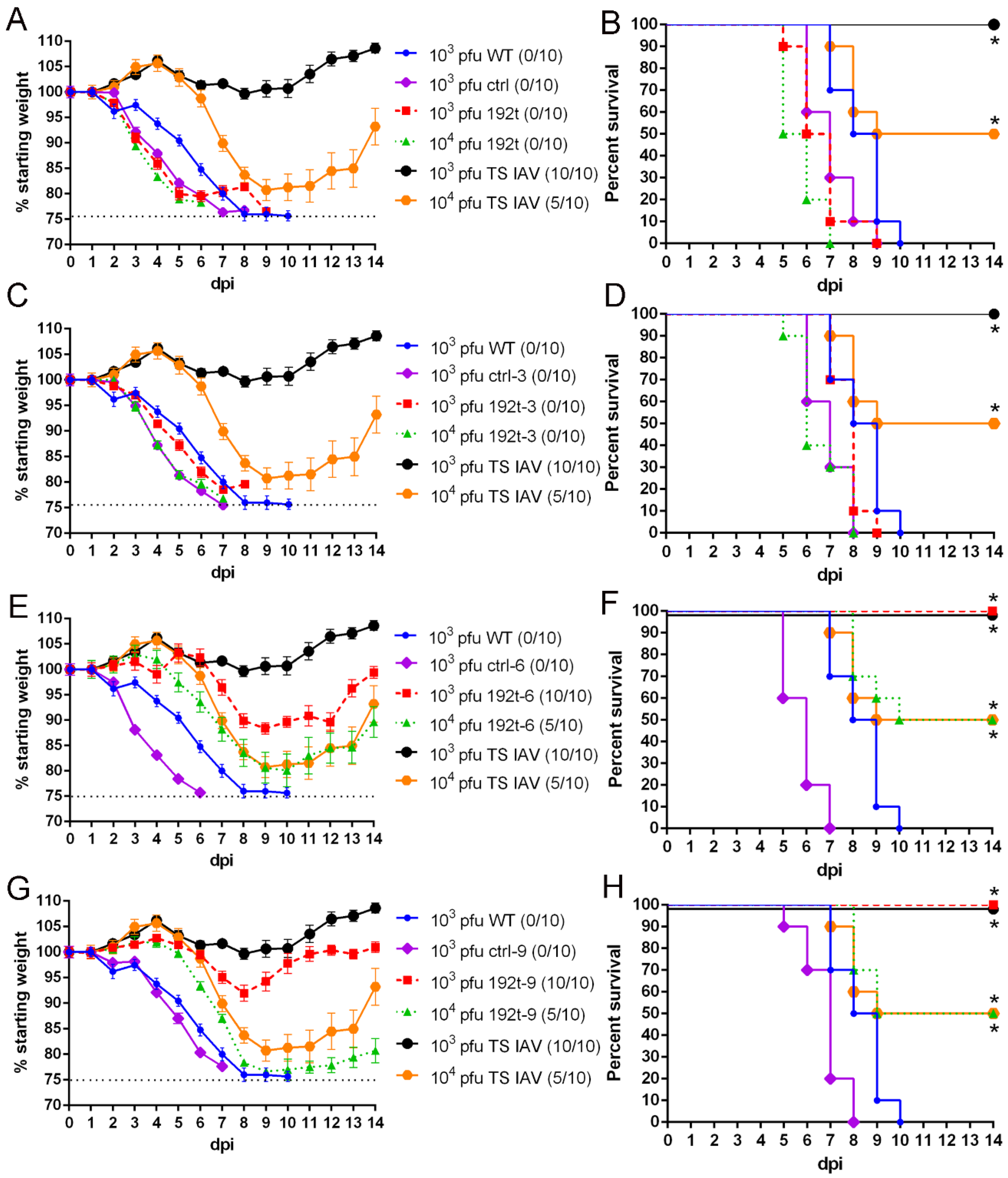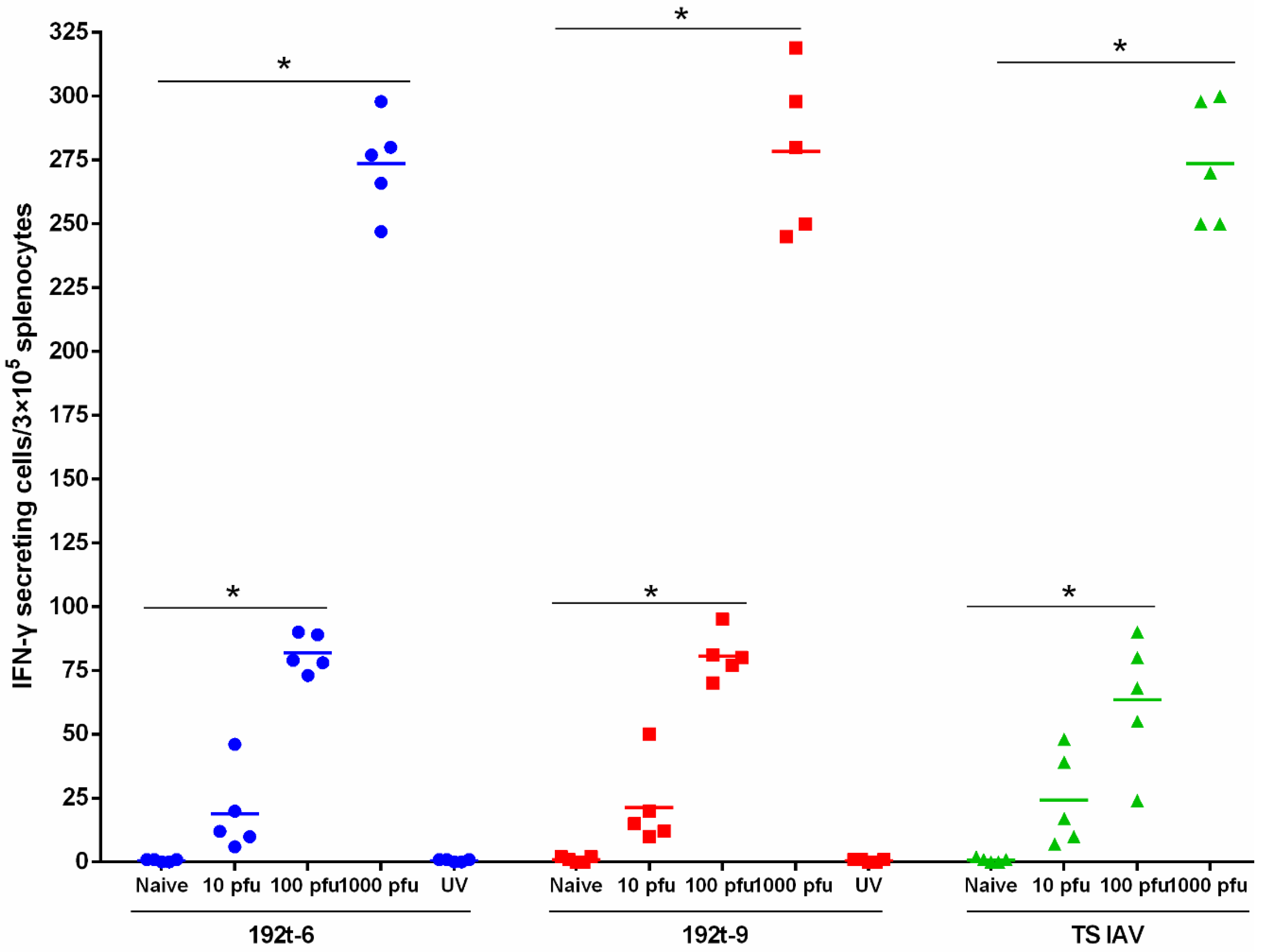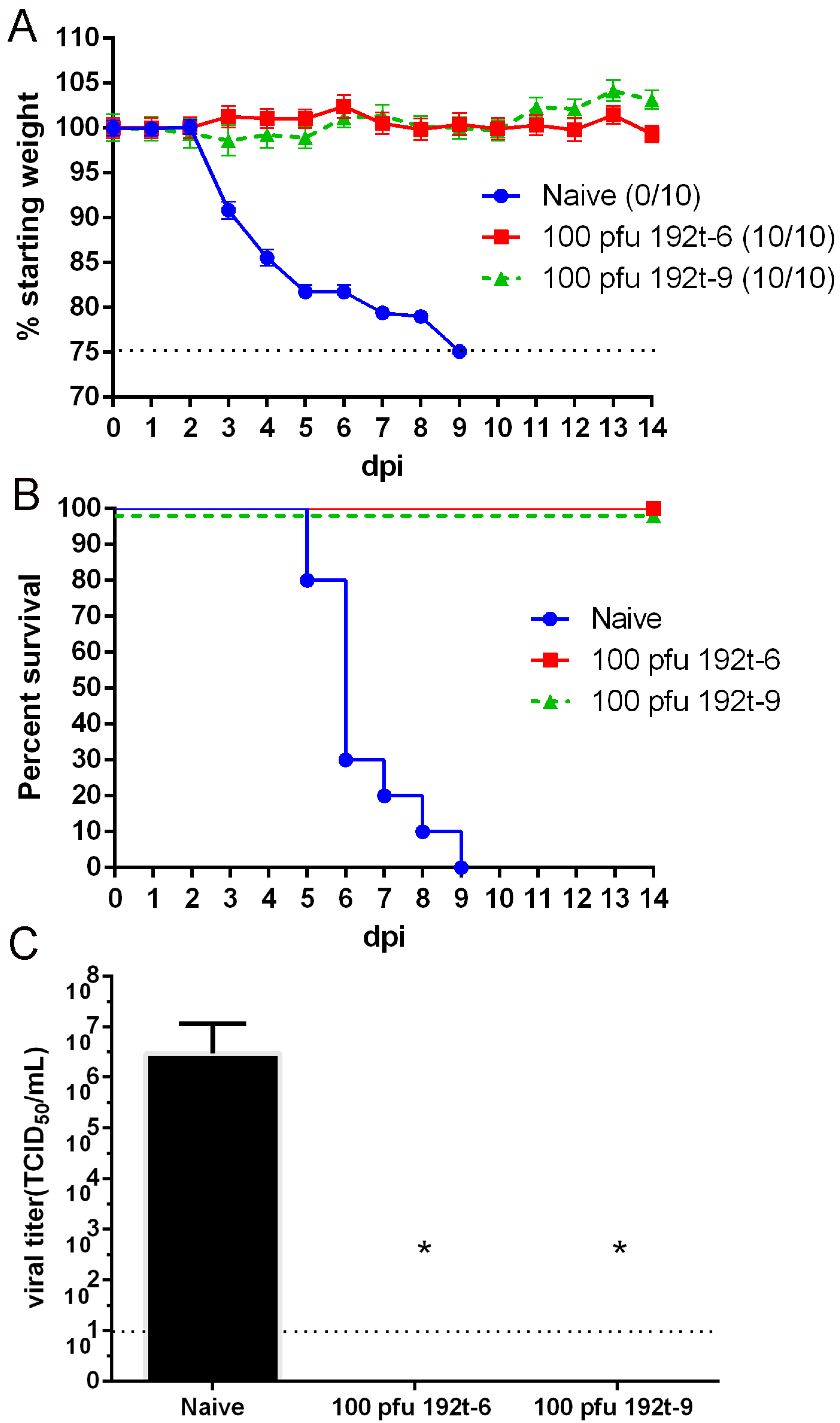MiRNA Targeted NP Genome of Live Attenuated Influenza Vaccines Provide Cross-Protection against a Lethal Influenza Virus Infection
Abstract
:1. Introduction
2. Materials and Methods
2.1. Cells, Viruses, and Mice
2.2. Plasmid Construction, Virus Rescue and Multicycle Growth Curve Analysis
2.3. MDCK Cells Transfection
2.4. RT-qPCR
2.5. Immunization and Viral Challenge
2.6. Enzyme-Linked Immunosorbent Assay (ELISA)
2.7. Enzyme-Linked Immune Spot Test (ELISpot)
2.8. Statistics
3. Results
3.1. Construction of Vaccines by Inserted with Different Perfect miRNA Target Sites
3.2. Viruses with Different Perfect miRNA Target Sites Inserted into NP Genome Segment Demonstrate Variable Attenuations in Cells
3.3. Viruses with Different Perfect miRNA Target Sites Inserted into NP Genome Segment Demonstrate Variable Attenuations in Mice
3.4. MiRNA Targeted Viruses of 192t-6 and 192t-9 Provide Protection from Homologous Virus Infection
3.5. MiRNA Targeted Viruses of 192t-6 and 192t-9 Provide Protective Immunity during Lethal Challenge of Homologous Virus
3.6. MiRNA Targeted Viruses of 192t-6 and 192t-9 Provide Protection Against Heterosubtypic Virus Challenge
4. Discussion
Author Contributions
Funding
Conflicts of Interest
References
- Wan, Z.; Cardenas, G.S.; Liu, J.; Santos, J.; Carnaccini, S.; Geiger, G.; Ferreri, L.; Rajao, D.; Perez, D.R. An alternative strategy as a quadrivalent live attenuated influenza virus vaccine. J. Virol. 2018, 92. [Google Scholar] [CrossRef] [PubMed] [Green Version]
- Greenberg, D.P.; Robertson, C.A.; Noss, M.J.; Blatter, M.M.; Rex, B.; Decker, M.D. Safety and immunogenicity of a quadrivalent inactivated influenza vaccine compared to licensed trivalent inactivated influenza vaccines in adults. Vaccine 2013, 31, 770–776. [Google Scholar] [CrossRef]
- Heinonen, S.; Silvennoinen, H.; Lehtinen, P.; Vainionpää, R.; Ziegler, T.; Heikkinen, T. Effectiveness of inactivated influenza vaccine in children aged 9 months to 3 years: An observational cohort study. Lancet Infect. Dis. 2011, 11, 23–29. [Google Scholar] [CrossRef]
- Nordin, J.D.; Elyse, O.K.; Gabriela, V.B.; Kristin, N.; Heather, L.; Allison, N.; Lee, G.M.; Simon, H.; Wei, S.; Avalow, O. Maternal safety of trivalent inactivated influenza vaccine in pregnant women. Obstet. Gynecol. 2013, 121, 519–525. [Google Scholar] [CrossRef]
- Bandell, A.R.; Sim, E.A.F. Live attenuated influenza vaccine tetravalent: A clinical review. Expert Rev. Vaccines 2015, 14, 963–973. [Google Scholar] [CrossRef] [PubMed]
- Khan, A.S.; Polezhaev, F.; Vasiljeva, R.; Drinevsky, V.; Buffington, J.; Gary, H.; Sominina, A.; Keitel, W.; Regnery, H.; Lonskaya, N.L. Comparison of US Inactivated Split-Virus and Russian Live Attenuated, Cold-Adapted Trivalent Influenza Vaccines in Russian Schoolchildren. J. Infect. Dis. 1996, 173, 453–456. [Google Scholar] [CrossRef] [PubMed] [Green Version]
- Zheng, D.; Yi, Y.; Chen, Z. Development of Live-Attenuated Influenza Vaccines against Outbreaks of H5N1 Influenza. Viruses 2012, 4, 3589–3605. [Google Scholar] [CrossRef] [Green Version]
- Steffen, M.J.; Robert, C.; Dimitris, P.; Ward, C.B.; Anjaruwee, N.; Bruce, F.; Steven, S.; Eckard, W. Live attenuated influenza virus vaccines by computer-aided rational design. Nat. Biotechnol. 2010, 28, 723–726. [Google Scholar]
- Shi, S.; Chen, S.; Han, W.; Wu, B.; Zhang, X.; Tang, Y.; Wang, X.; Zhu, Y.; Peng, D.; Liu, X. Cross-clade protective immune responses of NS1-truncated live attenuated H5N1 avian influenza vaccines. Vaccine 2016, 34, 350–357. [Google Scholar] [CrossRef]
- John, S.; Lowen, A.C.; Lindomar, P.; Matthew, A.; Alicia, S.; Randy, A.; Perez, D.R.; Adolfo, G.S.; Peter, P. Live attenuated influenza viruses containing NS1 truncations as vaccine candidates against H5N1 highly pathogenic avian influenza. J. Virol. 2009, 83, 1742. [Google Scholar]
- Xiaoyue, S.; Wenkui, S.; Yi, S.; Zheng, X.; Xin, S. Altered viral replication and cell responses by inserting microRNA recognition element into PB1 in pandemic influenza A virus (H1N1) 2009. Mediators Inflamm. 2015, 2015, 976575. [Google Scholar]
- Langlois, R.A.; Andrew, V.; Chua, M.A.; Adolfo, G.S.; Tenoever, B.R. Hematopoietic-specific targeting of influenza A virus reveals replication requirements for induction of antiviral immune responses. Proc. Natl. Acad. Sci. USA 2012, 109, 12117–12122. [Google Scholar] [CrossRef] [PubMed] [Green Version]
- Langlois, R.A.; Albrecht, R.A.; Brian, K.; Troy, S.; Shapiro, J.S.; Courtney, F.; Matthew, A.; Chua, M.A.; Ana Silvia, G.R.; Kemin, X. MicroRNA-based strategy to mitigate the risk of gain-of-function influenza studies. Nat. Biotechnol. 2013, 31, 844. [Google Scholar] [CrossRef] [PubMed]
- Waring, B.M.; Sjaastad, L.E.; Fiege, J.K.; Fay, E.J.; Reyes, I.; Moriarity, B.; Langlois, R.A. microRNA-based attenuation of influenza virus across susceptible hosts. J. Virol. 2017, 92, 1717–1741. [Google Scholar] [CrossRef] [PubMed] [Green Version]
- Peng, S.; Wang, J.; Wei, S.; Li, C.; Zhou, K.; Hu, J.; Ye, X.; Yan, J.; Liu, W.; Gao, G.F. Endogenous Cellular microRNAs Mediate Antiviral Defense against Influenza A Virus. Mol. Ther. Nucleic Acids 2018, 10, 361. [Google Scholar] [CrossRef] [Green Version]
- Ingle, H.; Kumar, S.; Raut, A.A.; Mishra, A.; Kulkarni, D.D.; Kameyama, T.; Takaoka, A.; Akira, S.; Kumar, H. The microRNA miR-485 targets host and influenza virus transcripts to regulate antiviral immunity and restrict viral replication. Sci. Signal. 2015, 8, a126. [Google Scholar] [CrossRef]
- Wolf, S.; Wu, W.; Jones, C.; Perwitasari, O.; Mahalingam, S.; Tripp, R.A. MicroRNA Regulation of Human Genes Essential for Influenza A (H7N9) Replication. PLoS ONE 2016, 11, e155104. [Google Scholar] [CrossRef]
- Zou, P.; Zhu, M.; Lian, C.; Wang, J.; Chen, Z.; Zhang, X.; Yang, Y.; Chen, X.; Cui, X.; Liu, J.; et al. miR-192-5p suppresses the progression of lung cancer bone metastasis by targeting TRIM44. Sci. Rep. 2019, 9, 19619. [Google Scholar] [CrossRef] [Green Version]
- Kim, J.H.; Lee, C.H.; Lee, S. Exosomal Transmission of MicroRNA from HCV Replicating Cells Stimulates Transdifferentiation in Hepatic Stellate Cells. Mol. Ther. Nucleic Acids 2019, 14, 483–497. [Google Scholar] [CrossRef] [Green Version]
- Wang, X.; Zhang, W.; Zheng, M.; Zheng, D.; Zhang, T.; Yi, Y.; Ding, Y.; Luo, J.; Dai, C.; Wang, H. Intranasal immunization with live attenuated influenza vaccine plus chitosan as an adjuvant protects mice against homologous and heterologous virus challenge. Arch. Virol. 2012, 157, 1451–1461. [Google Scholar] [CrossRef]
- Peng, B.; Peng, N.; Zhang, Y.; Zhang, F.; Li, X.; Chang, H.; Fang, F.; Wang, F.; Lu, F.; Chen, Z. Comparison of the Protective Efficacy of Neutralizing Epitopes of 2009 Pandemic H1N1 Influenza Hemagglutinin. Front. Immunol. 2017, 8, 1070. [Google Scholar] [CrossRef] [PubMed] [Green Version]
- Chaoyang, H.; Huadong, W.; Shuting, W.; Haiyan, C.; Lalan, L.; Bo, P.; Fang, F.; Ze, C. Comparison of multiple DNA vaccines for protection against cytomegalovirus infection in BALB/c mice. Virol. J. 2014, 11, 104. [Google Scholar]
- Zhou, B.; Meliopoulos, V.A.; Wang, W.; Lin, X.; Stucker, K.M.; Halpin, R.A.; Stockwell, T.B.; Schultz-Cherry, S.; Wentworth, D.E. Reversion of Cold-Adapted Live Attenuated Influenza Vaccine into a Pathogenic Virus. J. Virol. 2016, 90, 8454. [Google Scholar] [CrossRef] [Green Version]
- Agostini, A.; Brunetti, M.; Davidson, B.; Tropé, C.G.; Eriksson, A.G.Z.; Heim, S.; Panagopoulos, I.; Micci, F. The microRNA miR-192/215 family is upregulated in mucinous ovarian carcinomas. Sci. Rep. 2018, 8, 11069. [Google Scholar] [CrossRef]
- Sayadi, M.; Ajdary, S.; Nadali, F.; Rostami, S.; Edalati, F.M. Tumor suppressive function of microRNA-192 in acute lymphoblastic leukemia. Bosn. J. Basic Med. Sci. 2017, 17, 248–254. [Google Scholar] [CrossRef] [Green Version]
- van der Ree, M.H.; Jansen, L.; Kruize, Z.; van Nuenen, A.C.; van Dort, K.A.; Takkenberg, R.B.; Reesink, H.W.; Kootstra, N.A. Plasma microRNA levels are associated with HBeAg status and treatment response in chronic hepatitis B patients. J. Infect. Dis. 2017, 215, 1421. [Google Scholar] [CrossRef]
- Wang, J.; Chen, J.; Liu, Y.; Zeng, X.; Wei, M.; Wu, S.; Xiong, Q.; Song, F.; Yuan, X.; Xiao, Y.; et al. Hepatitis B Virus Induces Autophagy to Promote its Replication by the Axis of miR-192-3p-XIAP Through NF kappa B Signaling. Hepatology 2019, 69, 974–992. [Google Scholar] [CrossRef]
- Zhang, P.; Wang, L.; Li, Y.; Jiang, P.; Wang, Y.; Wang, P.; Kang, L.; Wang, Y.; Sun, Y.; Jiang, Y. Identification and characterization of microRNA in the lung tissue of pigs with different susceptibilities to PCV2 infection. Vet. Res. 2018, 49, 18. [Google Scholar] [CrossRef] [Green Version]
- Gui, B.; Chen, Q.; Hu, C.; Zhu, C.; He, G. Effects of calcitriol (1, 25-dihydroxy-vitamin D3) on the inflammatory response induced by H9N2 influenza virus infection in human lung A549 epithelial cells and in mice. Virol. J. 2017, 14, 10. [Google Scholar] [CrossRef] [Green Version]
- Filipowicz, W.; Bhattacharyya, S.N.; Sonenberg, N. Mechanisms of post-transcriptional regulation by microRNAs: Are the answers in sight? Nat. Rev. Genet. 2008, 9, 102–114. [Google Scholar] [CrossRef]
- Vemula, S.V.; Sayedahmed, E.E.; Sambhara, S.; Mittal, S.K. Vaccine approaches conferring cross-protection against influenza viruses. Expert Rev. Vaccines 2017, 16, 1141–1154. [Google Scholar] [CrossRef] [PubMed]
- Brostoff, T.; Pesavento, P.A.; Barker, C.M.; Kenney, J.L.; Dietrich, E.A.; Duggal, N.K.; Bosco-Lauth, A.M.; Brault, A.C. MicroRNA reduction of neuronal West Nile virus replication attenuates and affords a protective immune response in mice. Vaccine 2016, 34, 5366–5375. [Google Scholar] [CrossRef] [PubMed] [Green Version]
- Belshe, R.B.; Gruber, W.C.; Mendelman, P.M.; Mehta, H.B.; Mahmood, K.; Reisinger, K.; Treanor, J.; Zangwill, K.; Hayden, F.G.; Bernstein, D.I. Correlates of immune protection induced by live, attenuated, cold-adapted, trivalent, intranasal influenza virus vaccine. J. Infect. Dis. 2000, 181, 1133–1137. [Google Scholar] [CrossRef] [PubMed] [Green Version]
- Du, Y.; Xin, L.; Shi, Y.; Zhang, T.H.; Wu, N.C.; Dai, L.; Gong, D.; Brar, G.; Shu, S.; Luo, J. Genome-wide identification of interferon-sensitive mutations enables influenza vaccine design. Science 2018, 359, 290–296. [Google Scholar] [CrossRef] [Green Version]
- Gauger, P.C.; Loving, C.L.; Surender, K.; Alessio, L.; Perez, D.R.; Kehrli, M.E.; Roth, J.A.; Hana, G.; Vincent, A.L. Live attenuated influenza A virus vaccine protects against A(H1N1)pdm09 heterologous challenge without vaccine associated enhanced respiratory disease. Virology 2014, 471–473, 93–104. [Google Scholar] [CrossRef] [Green Version]
- Ambrose, C.S.; Yi, T.; Falloon, J. An integrated, multistudy analysis of the safety of Ann Arbor strain live attenuated influenza vaccine in children aged 2-17 years. Influenza Other Respir. Viruses 2011, 5, 389–397. [Google Scholar] [CrossRef] [Green Version]
- Jin, H.; Subbarao, K. Live Attenuated Influenza Vaccine. Curr. Top. Microbiol. Immunol. 2014, 386, 181–204. [Google Scholar]
- Joseph, T.; McAuliffe, J.; Lu, B.; Vogel, L.; Swayne, D.; Jin, H.; Kemble, G.; Subbarao, K. A live attenuated cold-adapted influenza A H7N3 virus vaccine provides protection against homologous and heterologous H7 viruses in mice and ferrets. Virology 2008, 378, 123–132. [Google Scholar] [CrossRef] [Green Version]
- Perez, J.T.; Pham, A.M.; Lorini, M.H.; Chua, M.A.; John, S.; Tenoever, B.R. MicroRNA-mediated species-specific attenuation of influenza A virus. Nat. Biotechnol. 2009, 27, 572. [Google Scholar] [CrossRef]






| Group | Dose (pfu/20 μL) | Lung Virus Titer a (Log10TCID50/mL) | Survival Rate (No. of Survivors/No. Tested) |
|---|---|---|---|
| 192t | 103 | 5.67 ± 0.89 | 0/10 |
| 104 | 6.60 ± 0.28 | 0/10 | |
| 192t-3 | 103 | 5.13 ± 0.46 | 0/10 |
| 104 | 6.33 ± 0.34 | 0/10 | |
| 192t-6 | 103 | ND | 10/10 |
| 104 | 2.42 ± 0.49 | 5/10 | |
| 192t-9 | 103 | ND | 10/10 |
| 104 | 2.44 ± 0.16 | 5/10 | |
| TS IAV | 103 | ND | 10/10 |
| 104 | 2.39 ± 0.08 | 5/10 | |
| ctrl | 103 | 6.10 ± 0.42 | 0/10 |
| ctrl-3 | 103 | 5.80 ± 0.76 | 0/10 |
| ctrl-6 | 103 | 5.83 ± 0.24 | 0/10 |
| ctrl-9 | 103 | 5.47 ± 0.49 | 0/10 |
| WT | 103 | 5.90 ± 0.36 | 0/10 |
| Group | Virus-Specific Antibody Titer (ELISA, 2n) a | ||||
|---|---|---|---|---|---|
| Serum IgG | Lung Homogenate IgA | Serum IgG1 | Serum IgG2a | Serum IgG2b | |
| 10 pfu 192t-6 | 16.8 ± 2.17 | 7.6 ± 0.89 | 12.8 ± 1.79 | 14.4 ± 0.89 | 13.0 ± 1.23 |
| 100 pfu 192t-6 | 17.6 ± 0.89 | 10.2 ± 0.84 | 16.0 ± 0.71 | 17.6 ± 0.89 | 16.4 ± 0.89 |
| 1000 pfu 192t-6 | 20.8 ± 0.45 | 13.8 ± 0.96 | 17.2 ± 1.10 | 18.2 ± 0.45 | 17.2 ± 2.17 |
| 10 pfu 192t-9 | 15.4 ± 4.10 | 7.2 ± 0.84 | 12.0 ± 3.00 | 13.4 ± 1.14 | 12.0 ± 2.12 |
| 100 pfu 192t-9 | 17.4 ± 1.14 | 10.4 ± 0.55 | 16.8 ± 1.10 | 17.2± 1.10 | 15.4 ± 1.14 |
| 1000 pfu 192t-9 | 20.4 ± 0.55 | 13.0 ± 1.58 | 17.4± 0.55 | 19.0 ± 0.71 | 16.8 ± 1.79 |
| 10 pfu TS IAV | 9.2 ± 3.27 | 5.2 ± 0.84 | 8.8 ± 4.44 | 11.8 ± 1.79 | 9.2 ± 4.15 |
| 100 pfu TS IAV | 11.6 ± 3.91 | 8.6 ± 1.52 | 10.8 ± 2.95 | 13.2 ± 1.10 | 11.2 ± 1.30 |
| 1000 pfu TS IAV | 19.3 ± 0.58 | 12.2 ± 1.30 | 14.2 ± 1.10 | 14.2 ± 1.10 | 13.4 ± 1.14 |
| UV 192t-6 | 2.4 ± 0.55 | 3.0 ± 0.71 | 2.8 ± 0.84 | 2.6 ± 0.89 | 2.8 ± 0.84 |
| UV 192t-9 | 2.4 ± 0.55 | 2.8 ± 0.45 | 3.0 ± 0.71 | 3.2 ± 0.84 | 3.4 ± 0.89 |
| Naive | — b | — | — | — | — |
© 2020 by the authors. Licensee MDPI, Basel, Switzerland. This article is an open access article distributed under the terms and conditions of the Creative Commons Attribution (CC BY) license (http://creativecommons.org/licenses/by/4.0/).
Share and Cite
Gao, F.; Yang, T.; Liu, X.; Xiong, F.; Luo, J.; Yi, Y.; Fan, J.; Chen, Z.; Tan, W.-S. MiRNA Targeted NP Genome of Live Attenuated Influenza Vaccines Provide Cross-Protection against a Lethal Influenza Virus Infection. Vaccines 2020, 8, 65. https://doi.org/10.3390/vaccines8010065
Gao F, Yang T, Liu X, Xiong F, Luo J, Yi Y, Fan J, Chen Z, Tan W-S. MiRNA Targeted NP Genome of Live Attenuated Influenza Vaccines Provide Cross-Protection against a Lethal Influenza Virus Infection. Vaccines. 2020; 8(1):65. https://doi.org/10.3390/vaccines8010065
Chicago/Turabian StyleGao, Feixia, Tianhan Yang, Xueying Liu, Feifei Xiong, Jian Luo, Yinglei Yi, Jiangfeng Fan, Ze Chen, and Wen-Song Tan. 2020. "MiRNA Targeted NP Genome of Live Attenuated Influenza Vaccines Provide Cross-Protection against a Lethal Influenza Virus Infection" Vaccines 8, no. 1: 65. https://doi.org/10.3390/vaccines8010065
APA StyleGao, F., Yang, T., Liu, X., Xiong, F., Luo, J., Yi, Y., Fan, J., Chen, Z., & Tan, W.-S. (2020). MiRNA Targeted NP Genome of Live Attenuated Influenza Vaccines Provide Cross-Protection against a Lethal Influenza Virus Infection. Vaccines, 8(1), 65. https://doi.org/10.3390/vaccines8010065




